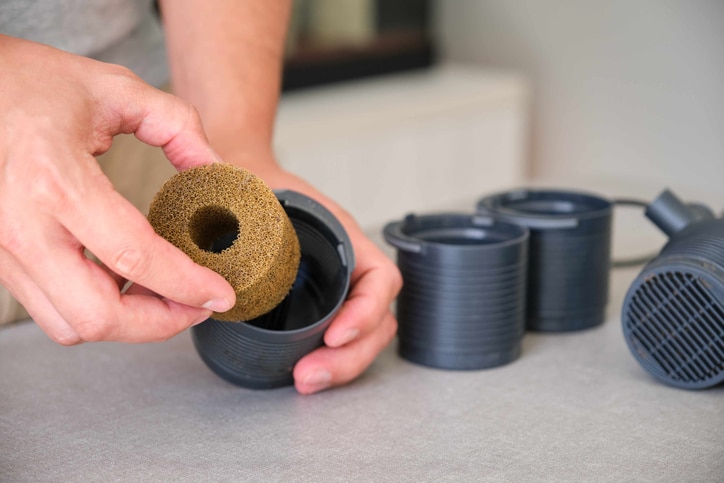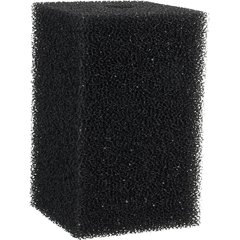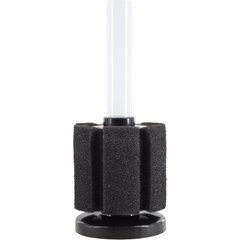When To Use Sponge Filters for Fish Tanks

Photo by Ladanifer/iStock / Getty Images Plus via Getty Images
Affordable, reliable, and low-maintenance, sponge filters are used by both professional aquarists and hobbyists to keep fish tanks clean.
Interested in adding a sponge filter to your at-home tank? Discover everything you need to know, from installation and maintenance to expert tips.
What Is a Sponge Filter?
First things first: What is a sponge filter?
A sponge filter is a type of filter that uses a porous sponge to trap debris—such as fish waste and excess food—in an aquarium. This is a process known as mechanical filtration.
Additionally, the sponge’s porous surface provides an ideal environment for beneficial bacteria to grow. These bacteria break down tank toxins, such as ammonia and nitrites, in a process known as biological filtration.
How Does a Sponge Filter Work?
A sponge filter system has three components:
- Sponge
- Air pump
- Tubing that connects the sponge and the pump
The air pump pushes air through the tubes and sponge, which causes bubbles to rise from inside the sponge while drawing water through the sponge’s walls. While inside the sponge, any debris in the water is trapped inside the sponge.
“They’re really, really simple,” says Doug Ludemann, a professional aquarist and owner of Fish Geeks, an aquarium maintenance company based in Minneapolis. “They’re different than your typical filter, where the water is flowing through the aquarium—it’s just air moving through a tube, drawing water into a sponge.”
Sponge filters can work in any type of aquarium, says Ludemann, but are most often used for hospital tanks (which house sick fish or new fish being quarantined) and breeding tanks with baby fish.
“Sponge filters are gentle and don’t create a current, so they’re great for small fish, sick fish, and other types of fish that aren’t great swimmers,” says Ludemann.
Pros and Cons of Aquarium Sponge Filters
Benefits of Sponge Filters
Sponge filters for fish tanks offer some benefits over other types of filtration systems, including:
- Gentle process: Sponge filters for aquariums don’t cause currents, which is ideal for sick fish, small fish, and fish that aren’t naturally efficient swimmers, such as seahorses.
- Biological filtration: In addition to mechanically filtering out debris, sponge filters encourage biological filtration by providing a surface for beneficial bacteria to colonize.
- Easy maintenance: Sponge filters are easy to install and only need to be cleaned two to four times a month, says Ludemann. “You simply put them in a bucket of tank water, squeeze them, and the gunk comes out,” he explains.
Downsides of Sponge Filters
Potential drawbacks of sponge filtration include the following:
- Aesthetics: Aquarium sponge filters take up space inside the tank and can be bulky, making them less popular choices for display tanks.
- Heavily populated tanks: Tanks with large populations of fish may need more powerful filters.
- Less water flow: If your tank’s environment requires more robust water flow, sponge filters aren’t appropriate.
The Best Fish Tank Sponge Filters
When purchasing a sponge filter, consider the size of your tank (larger tanks need larger sponges) and the sponge’s pore size.
Ludemann recommends selecting a sponge with a fine pore size; while they will need to be cleaned more often than coarse sponges, smaller pores trap more debris.
“The key to filtration is providing a large amount of surface area in a small space, so you want a sponge filter made from a finer mesh or foam,” he explains.
Recommended Products
How To Set Up an Aquarium Sponge Filter
When setting up your sponge filter, follow these steps:
- Prepare your supplies. In addition to the sponge, you’ll need an air pump and airline tubing.
- Connect the tubing. Connect one end of the tubing to the plastic nipple on your sponge filter; connect the other end to the air pump.
- Place the sponge underwater. If it floats, squeeze out any air bubbles. Ideally, the sponge filter should sit near the bottom of the tank.
- Clean regularly. Ludemann recommends cleaning your sponge filter two to four times a month. Simply fill a bucket with tank water and squeeze the sponge underwater several times until it’s free of debris.
- Replace when needed. Replace your fish tank sponge filter once you notice damage or decay to the sponge.
Whether you’re a professional, hobbyist, or beginner, aquarium sponge filters can be a great way to keep your tank clean and fish healthy.
This content was medically reviewed by Melissa Witherell, DVM, Chewy veterinarian.





